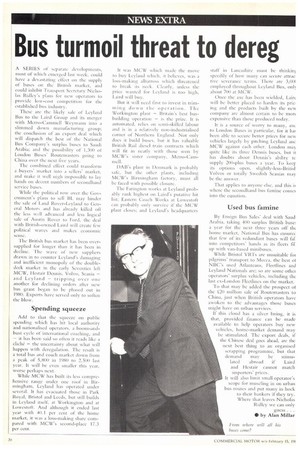Bus turmoil threat to dereg
Page 20

If you've noticed an error in this article please click here to report it so we can fix it.
A SERIES of separate developments, most of which emerged last week. could have a devastating effect on the supply of buses on the British market, and could inhibit Transport Secretary Nicholas Ridley's plans for new operators to provide low-cost competition for the established bus industry.
These are the likely sale of Leyland Bus to the Laird Group and its merger with Metro-Cammell Weymann into a slimmed down manufacturing group; the conclusion of an export deal which will dispatch the best of the National Bus Company's surplus buses to Saudi Arabia; and the possibility of 1,300 of London Buses' Routemasters going to China over the next five years.
The combined effect could transform a buyers' market into a sellers market, and make it well nigh impossible to lay hands on decent numbers of secondhand service buses.
While the political row over the Government's plans to sell BL may hinder the sale of Land Rover-Leyland to General Motors and has already killed off the less well advanced and less logical sale of Austin Rover to Ford, the deal with British-owned Laird will create few political waves and makes economic sense.
The British bus market has been oversupplied for longer than it has been in decline. The wave of new suppliers drawn in to counter Leyland's damaging and inefficient monopoly of the doubledeck market in the early Seventies left MCW, Hestair Dennis, Volvo. Scania — and Leyland — tripping over one another for declining orders after new bus grant began to be phased out in 1980. Exports have served only to soften the blow.
Spending squeeze
Add to that the squeeze on public spending which has hit local authority and nationalised operators, a boom-andbust cycle of international coaching, and — it has been said so often it reads like a clich6 — the uncertainty about what will happen with deregulation. The result is a total bus and coach market down from a peak of 5,800 in 1981) to 2,500 last year. It will be even smaller this year, worse perhaps next.
While MCW has built its less comprehensive range under one roof in Birmingham, Leyland has operated under several. It has evacuated those in Park Royal, Bristol and Leeds, hut still builds in Leyland itself, at Workington and at Lowestoft. And although it ended last year with 40.1 per cent of' the home market, it was a loss-making share compared with MCW's second-place 17.3 per cent.
It was MCW which made the move to buy Leyland which, it believes, was a loss-making albatross which threatened to break its neck. Clearly, unless the price wanted for Leyland is too high, Laird will buy,
But it will need first to invest in trimming down the operation. The Workington plant — Britain's best busbuilding operation — is the prize. It is automated, relies on semi-skilled labour and is in a relatively non-industrialised corner of Northern England. Not only does it build buses, but it has valuable British Rail diesel train contracts which will tit in neatly with those won by MCW's sister company, Metro-Cammell.
DAB's plant in Denmark is probably safe, but the other plants. including MCW's Birmingham factory, must all be faced with possible closure.
The Farington works at Leyland probably rank highest on Laird's putative hit list; Eastern Coach Works at Lowestoft can probably only survive if the MCW plant closes; and Leyland's headquarters
staff in Lancashire must he thinkim speedily of how many can secure attractive severance terms. There are 3,001 employed throughout Leyland Bus, onh about 700 at MCW.
Once the axe has been wielded, Lair( will be better placed to harden its pricing and the products built by the new company are almost certain to be mon expensive than those produced today.
It is a source of worry to many, an to London Buses in particular, for it kn been able to secure better prices for new vehicles largely by pitching Leyland ant: MCW against each other. London ma) quite like its three Dennis buses, but ii has doubts about Dennis's ability tc supply 200-plus buses a year. To keer its options open, slightly-less-Britist Volvos or totally Swedish Scanias may be the answer.
That applies to anyone else, and this is where the secondhand bus famine conies into the equation.
Used bus famine
By Ensign Bus Sales' deal with Saud Arabia, taking 4(X) surplus British busc! a year for the next three years off du home market, National Bus has ensurec that few of its redundant buses will fal. into competitors' hands as its fleets fir up with van-based minibuses.
While Bristol VRTs are unsuitable for pilgrims' transport to Mecca, the best of NBC's used Atlanteans. Fleetlines and Leyland Nationals are; so are some other operators' surplus vehicles, including the last ex-London Fleetlines on the market.
To that may be added the prospect of the S:21) million sale of Routemasters to China, just when British operators have awoken to the advantages those buses might have on urban services.
If this cloud has a silver lining, it is that, provided finance can be made available to help operators buy new vehicles, home-market demand may be stimulated. The export deals, if the Chinese deal goes ahead, are the next best thing to an organised scrapping programme, but that demand may be stimu
lated abroad if Laird and Hestair cannot match importers' prices.
It will also limit small operator's scope for muscling in on urban bus routes and put many in hock to their bankers if they try. Where that leaves Nicholas Ridley we can only guess .. .
• by Alan Millar






















































